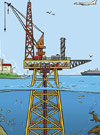Cased and perforated completion is the most common type of completion which is selected my many companies. For this completion, a production casing or a liner is cemented through reservoir zone(s) and subsequently, a well is perforated in order to provide communication between the formation and wellbore.
Perforation should ideally penetrate deeper rather than nearer a wellbore damage zone around a wellbore so fluid from a reservoir can effectively flow into a wellbore. Additionally, several depth control methods help to accurately select which section of reservoir to be perforated. Hence, undesired zones, such as gas, water or weak formation can be avoided and this will improve well production efficiency.
Cementing around the wellbore is one of the critical parts for this completion because good cement will effectively isolate all zones and allows a wellbore to produce from several zones without communication between reservoirs. Moreover, packers are run into a wellbore to isolate reservoir fluid when it flows into a wellbore.
Another important feature of this completion is the ability to selectively produce or inject into any reservoir. A sliding sleeve on each zone can be opened and closed to allow selective production or injection operation. Figure 1 illustrates the diagram of cased and perforated completion.

Figure 1- Example of Cased and Perforated Schematic
Advantages of cased and perforated completions
- Safer operations
- Better zonal isolation
- Facilitation of selective perforation and stimulation
- Effective way to complete multiple zones in one well
- Better reservoir management
- Ability to shut off any undesirable productions such as water, gas, or sand
- Long term cost effective
- Ability to work over and recomplete the well
- Better well integrity
- Less sand production than open hole completion
Disadvantages of cased and perforated completions
- Extra cost for casing, cementing, perforation and completion equipment.
- Lower reservoir exposure than open hole completion
References
Jonathan Bellarby, 2009. Well Completion Design, Volume 56 (Developments in Petroleum Science). 1 Edition. Elsevier Science.
Wan Renpu, 2011. Advanced Well Completion Engineering, Third Edition. 3 Edition. Gulf Professional Publishing.
Ted G. Byrom, 2014. Casing and Liners for Drilling and Completion, Second Edition: Design and Application (Gulf Drilling Guides). 2 Edition. Gulf Professional Publishing.




















































































